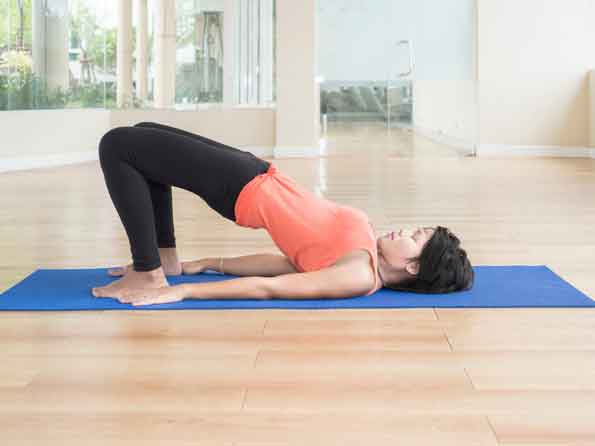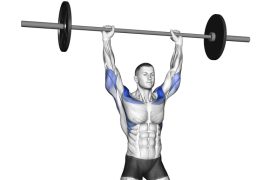The Bridge Pose is a versatile yoga posture that strengthens the legs, tones the core, and enhances flexibility. It helps improve posture, increase spinal mobility, and relieve stress while promoting better blood circulation. Ideal for those who sit for long hours, it counteracts slouching and tight hip muscles. Whether for lower body toning or post-workout stretching, this pose offers numerous benefits. However, it should be avoided by individuals with neck, back, or knee issues to prevent strain or injury.
Bridge Pose:
The Bridge Pose, or Setu Bandhasana in Sanskrit, is a chest-opening yoga posture that stretches the chest, thighs, and spine. This asana involves lifting the hips and upper body off the ground while pressing the arms into the mat, forming a bridge-like shape. In Sanskrit, setu means “bridge,” and bandha means “lock.” A beginner-friendly pose, it is often performed at the end of a yoga session, particularly after standing workouts, to help warm up and mobilize the spine.
How to Do Bridge Pose (Setu Bandhasana):
Bridge Pose (Setu Bandhasana) is a fantastic yoga pose that targets your core, glutes, and legs while also stretching your chest and shoulders. Follow these 10 steps to perform Bridge Pose correctly:
1. Start on Your Back: Lie on your back with your knees bent and feet hip-width apart. Keep your arms by your sides with your palms facing down, fingers extended.
2. Feet Placement: Place your feet firmly on the mat, making sure they are close enough to your glutes. Keep your feet hip-width apart.
3. Engage Your Core: Engage your core and gently press your lower back into the floor, removing any space between your spine and the mat. This will help you stabilize your lower body.
4. Lift Your Hips: Inhale deeply and press down through your feet to begin lifting your hips toward the ceiling. As you do, lift your spine off the floor one vertebra at a time.
5. Alignment: Ensure your thighs are parallel, knees aligned with your hips, and your head, neck, and shoulders are resting flat on the floor. Engage your inner thighs to maintain stability.
6. Clasp Your Hands: If comfortable, you can clasp your hands underneath your back and press your arms into the mat to support the lift. Make sure your knees stay directly over your heels.
7. Hold the Pose: Hold the bridge pose for 30 seconds to 1 minute (or for 5-10 deep breaths). Focus on engaging your glutes and core while breathing steadily.
8. Chin Position: Keep your chin slightly tucked to protect your neck. Avoid turning your head while holding the pose to maintain proper alignment.
9. Release the Pose: To come out of the pose, exhale and slowly lower your spine back down to the mat, gently bringing your hips to the floor.
10. Repeat: Perform 3 sets of 10-15 repetitions, focusing on controlled movements and deep breaths.
This powerful pose can help strengthen your lower body, improve posture, and relieve stress. Practice it regularly to enjoy its full benefits!
Mistakes to Avoid in Bridge Pose:
If you’re new to Bridge Pose, ensuring proper technique is essential for preventing injury and maximizing benefits. Avoid these common mistakes for a safe and effective practice:
1. Skipping the Warm-Up: Not warming up before Bridge Pose can increase the risk of straining your back and hips. Prepare your body with gentle stretches like Cat-Cow, pelvic tilts, and hamstring stretches to loosen up muscles and enhance flexibility.
2. Toes Pointing Outward: Turning your toes outward shifts knee alignment, putting excess pressure on your joints. Keep your feet parallel and toes pointing forward to ensure even weight distribution and knee protection.
3. Neglecting Inner Thigh Engagement: Failing to activate your inner thighs can cause your legs to splay outward, reducing stability. Squeeze your thighs inward to maintain proper alignment and enhance glute and thigh engagement.
4. Overarching the Chest: Lifting the chest too high misaligns the spine and strains the neck. Instead, focus on lifting the hips while keeping the chest relaxed and the spine lengthened.
5. Letting Knees Touch: Allowing your knees to collapse inward reduces glute and thigh activation. Keep them hip-width apart and parallel to avoid unnecessary strain on the knees.
6. Dropping the Hips: If your hips sag during the pose, it minimizes engagement and weakens the stretch. Maintain an active lift by engaging your glutes and core, keeping your hips elevated throughout the hold.
7. Overarching the Lower Back: Excessive arching can cause discomfort and strain. Engage your core to keep a neutral spine and roll up and down through your spine gradually to avoid pressure on your lower back.
Practice Bridge Pose with mindfulness, focusing on form and breath. This ensures that you gain strength and flexibility while avoiding unnecessary injuries. Happy practicing!
Benefits of Bridge Pose (Setu Bandhasana):
Bridge Pose is a versatile yoga posture that enhances flexibility, strength, and relaxation. Here are nine reasons why you should incorporate it into your routine:
1. Stretches the Neck and Spine: Bridge Pose releases tension in the neck and spine, improving posture and preventing stiffness caused by prolonged sitting.
2. Opens the Chest and Shoulders: Lifting the hips expands the chest and shoulders, promoting better posture and deeper breathing. It counteracts slouching and rounded shoulders.
3. Strengthens Core Muscles: This pose engages the abdominal muscles, strengthening the core, improving balance, and reducing lower back strain.
4. Tones Legs, Hips, and Glutes: Pressing through your feet and lifting your hips strengthens your legs, hips, and glutes, enhancing lower-body stability for daily activities.
5. Boosts Digestion: By stimulating the abdominal organs, Bridge Pose aids digestion, helping relieve bloating, gas, and constipation.
6. Improves Blood Circulation: The slight inversion increases blood flow to the brain, heart, and other organs, boosting energy levels and supporting heart health.
7. Enhances Spinal Mobility: Regular practice prevents back stiffness, enhances flexibility, and supports a wider range of motion in the spine.
8. Reduces Stress and Anxiety: By encouraging deep breathing and stimulating the nervous system, Bridge Pose helps calm the mind and reduce stress.
9. Supports Weight Management: Engaging multiple muscle groups helps boost metabolism, promoting muscle tone and fat loss over time.
Practicing Bridge Pose regularly can improve both physical and mental well-being, making it a great addition to your yoga routine!
Bridge Pose Variations:
If you want to modify or deepen your Bridge Pose (Setu Bandhasana), here are three variations to explore:
1. Bridge Pose with a Yoga Block:
- Place a yoga block under your lower back for support while lifting your hips.
- Helps reduce strain on the spine and allows for a longer, more comfortable hold.
2. Bridge Pose with a Yoga Strap:
- Wrap a yoga strap around your thighs (just above the knees) to prevent your legs from splaying outward.
- Encourages proper alignment and deeper engagement in the glutes and inner thighs.
3. Bridge Pose with Hands on the Mat:
- Instead of clasping your hands beneath you, keep them flat on the mat, palms down.
- Provides extra stability and is ideal for beginners or those with shoulder discomfort.
Tip: Experiment with these variations to find the one that best supports your flexibility and strength!
Who Should Avoid Bridge Pose?
While Bridge Pose offers numerous benefits, certain individuals should approach it with caution or avoid it altogether:
- Pregnant Women (Later Stages) – Lying on your back for prolonged periods can reduce blood flow and cause discomfort.
- People with Neck or Shoulder Issues – The pose puts pressure on these areas, which may lead to strain or injury.
- Individuals with Back Injuries – Those with existing spinal issues should avoid the pose to prevent further pain.
- People with Knee or Ankle Pain – The pressure on joints may worsen discomfort or existing conditions.
- Those with High Blood Pressure (Hypertension) – Bridge Pose can elevate blood pressure, so modifications or alternatives are recommended.
To practice safely, always follow proper form and listen to your body!
Disclaimer:
The information contained in this article is for educational and informational purposes only and is not intended as a health advice. We would ask you to consult a qualified professional or medical expert to gain additional knowledge before you choose to consume any product or perform any exercise.







